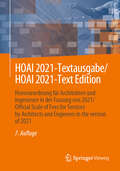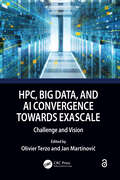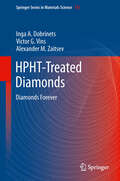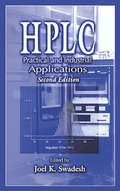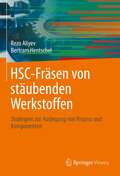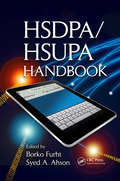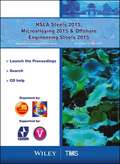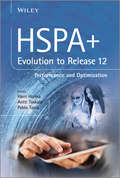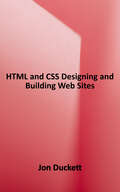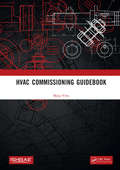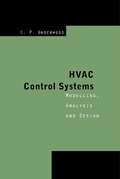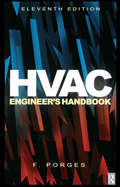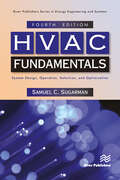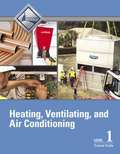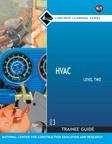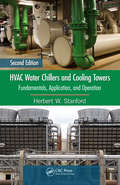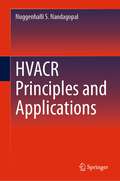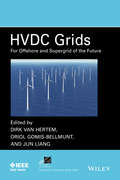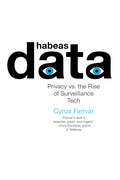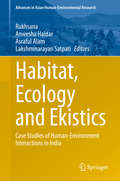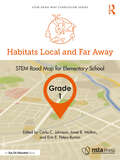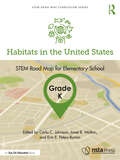- Table View
- List View
HOAI 2021-Textausgabe/HOAI 2021-Text Edition: Honorarordnung für Architekten und Ingenieure in der Fassung von 2021/Official Scale of Fees for Services by Architects and Engineers in the version of 2021
by Springer Fachmedien WiesbadenSeit der Öffnung des EU-Binnenmarktes sind ausländische Investoren und ausführende Firmen verstärkt auf dem deutschen Markt tätig. Umgekehrt möchten ausländische Auftraggeber wissen, nach welchen Bestimmungen ihr deutscher Architekt sein Honorar festlegt. Die 6. Auflage der zweisprachigen HOAI-Textausgabe wurde grundlegend überarbeitet. Im 1. Teil finden Sie den Wortlaut der HOAI 2021 in deutscher Fassung, im 2. Teil die englische Übersetzung.
HPC, Big Data, and AI Convergence Towards Exascale: Challenge and Vision
by Olivier TerzoHPC, Big Data, AI Convergence Towards Exascale provides an updated vision on the most advanced computing, storage, and interconnection technologies, that are at basis of convergence among the HPC, Cloud, Big Data, and artificial intelligence (AI) domains. Through the presentation of the solutions devised within recently founded H2020 European projects, this book provides an insight on challenges faced by integrating such technologies and in achieving performance and energy efficiency targets towards the exascale level. Emphasis is given to innovative ways of provisioning and managing resources, as well as monitoring their usage. Industrial and scientific use cases give to the reader practical examples of the needs for a cross-domain convergence. All the chapters in this book pave the road to new generation of technologies, support their development and, in addition, verify them on real-world problems. The readers will find this book useful because it provides an overview of currently available technologies that fit with the concept of unified Cloud-HPC-Big Data-AI applications and presents examples of their actual use in scientific and industrial applications.
HPHT-Treated Diamonds
by Victor. G. Vins Inga A. Dobrinets Alexander M. ZaitsevHigh-temperature and high-pressure treatment of diamond is becoming an important technology to elaborate diamonds. This is the first book providing a comprehensive review of the properties of HPHT-treated diamonds, based on the analysis of published data and the work of the authors. The book gives a detailed analysis of the physics of transformation of internal structures of diamonds subjected to HPHT treatment and discusses how these transformations can be detected using methods of optical microscopy and spectroscopy. It also gives practical recommendations for the recognition of HPHT-treated diamonds. The book is written in a language and terms which can be understood by a broad audience of physicists, mineralogists and gemologists.
HPLC: Practical and Industrial Applications, Second Edition (Analytical Chemistry)
by Joel K. SwadashProduct specifications, regulatory constraints, and tight production schedules impose considerable pressures on separation scientists in industry. The first edition of HPLC: Practical and Industrial Applications helped eliminate the need for extensive library or laboratory research when confronting a problem, an unfamiliar technique, or work in a n
HSC-Fräsen von stäubenden Werkstoffen: Strategien zur Auslegung von Prozess und Komponenten
by Rezo Aliyev Bertram HentschelDieses Werk für die Gestaltung des HSC-Fräsprozesses und dafür notwendiger Komponenten für stäubende Werkstoffe stellt eine praxisgerechte Vorgehensweise dar. Diese basiert auf wissenschaftlich gesicherten Grundlagen und unterstützt eine optimierende Gestaltung der Prozesskette. Der anhand praktischer Erfahrungen entwickelte mathematische Apparat untermauert die Abhängigkeiten der aufeinanderfolgenden Prozessschritte auf der Grundlage der technologischen Vererbung und erweitert die Grundprinzipien der Optimierung mehrstufiger Prozesse. Der Leser sollte Erfahrungen in der Gestaltung komplexerer Teilefertigungsprozesse mittels Fräsen mitbringen. Unter Nutzung der Werkstoffspezifika ist es ihm dann möglich eine breitere Anwendung der dargestellten Vorgehensweisen zu erreichen.
HSDPA/HSUPA Handbook
by Borko Furht Syed A. AhsonHigh Speed Packet Access (HSPA) is a collection of two mobile telephony protocols, High Speed Downlink Packet Access (HSDPA) and High Speed Uplink Packet Access (HSUPA). Allowing networks based on the Universal Mobile Telecommunications System to achieve data rates of several megabits per second, these powerful protocols are ideal for applications
HSLA Steels 2015, Microalloying 2015 and Offshore Engineering Steels 2015
by The Chinese Society for MetalsHSLA Steels 2015, Microalloying 2015 and Offshore Engineering Steels 2015 Conference Proceedings, Held November 11-13th, 2015, Hangzhou, Zhejiang Province, China
HSPA+ Evolution to Release 12: Performance and Optimization
by Antti Toskala Harri Holma Pablo TapiaA comprehensive reference book codifying the various standards releases for High Speed Packet Access (HSPA) wireless technology HSPA evolution has maintained its prominence through Releases 7-11 but the evolution is coming to an end with Release 12, with the focus moving to LTE. However, HSPA network and terminal sales will continue for many years: HSPA is expected to remain as the number one radio access technology from the sales point of view far beyond 2015. This timely book examines the complete HSPA evolution, and will be the ultimate long term reference for HSPA evolution. Headed by the successful editing team of Holma, Toskala and Tapia, industry experts look at HSPA evolution including complete Release 11 and the main additions in Release 12. They describe 3GPP definitions, field measurement, expected performance, practical optimization guidelines and the implications to the devices and to the networks. The book also covers MIMO antenna solutions and multicarrier evolution to provide higher data rates. Dedicated chapters include Continuous Packet Connectivity and High Speed Common Channels which provide major improvement to the smartphone capacity, end user performance and power consumption. The book assumes basic understanding of mobile communications yet the material is presented in an understandable way which can be enjoyed without any pre-information about MIMO or other technology solutions. A comprehensive reference book codifying the various standards releases for High Speed Packet Access (HSPA) wireless technology Leading editor and contributor team focusing their expertise on 3GPP features and performance, including Self Organizing Networks, LTE Interworking, Smartphone Optimization and Voice Evolution Dedicated chapter covering VoIP over HSPA, recognizing that telephony will continue to bring most of the revenues to mobile operators in the near future Includes tables, figures and plots illustrating the concepts or simulation results, to aid readers’ understanding of the topic An essential resource for R&D engineers by network, terminal and chip set vendors, network engineers with operators, application developers, regulators.
HTML & CSS Design and Build Websites
by Jon DuckettA two-book set for web designers and front-end developers This two-book set combines the titles HTML & CSS: Designing and Building Web Sites and JavaScript & jQuery: Interactive Front-End Development. Together these two books form an ideal platform for anyone who wants to master HTML and CSS before stepping up to JavaScript and jQuery. HTML & CSS covers structure, text, links, images, tables, forms, useful options, adding style with CSS, fonts, colors, thinking in boxes, styling lists and tables, layouts, grids, and even SEO, Google analytics, FTP, and HTML5. JavaScript & jQuery offers an excellent combined introduction to these two technologies using a clear and simple visual approach using diagrams, infographics, and photographs. - A handy two-book set that uniquely combines related technologies - Highly visual format and accessible language makes these books highly effective learning tools - Perfect for beginning web designers and front-end developers
HTO: Toronto's Water from Lake Iroquois to Lost Rivers and Low-flow Toilets (uTOpia)
by Wayne Reeves Christina PalassioDrained by a half-dozen major watersheds, cut by a network of deep ravines and fronting on a Great Lake, Toronto is dominated by water. Like most cities, though, Toronto has mismanaged its water, from the decades-long transformation of the citys creeks into sewersheds to the alteration of Torontos waterfront. Recently, the trend of fettering Torontos water and putting it underground has been countered by persistent citizen-led efforts to recall and restore the citys surface water. In HTO: Toronto's Water From Lake Iroquois to Lost Rivers to Low-flow Toilets, 30 contributors examine the ever-changing interplay between nature and culture, and call into question the citys past, present and future engagement with water.
HVAC Commissioning Guidebook
by Maija VirtaGreen buildings have become common in India and other countries in Asia. However, there is a concern regarding the performance of green buildings failing to meet the expectations of clients during the operation. One of the key reasons for this is poorly commissioned HVAC systems. In this publication we provide tools and knowhow for more efficient HVAC commissioning. It gives answers for four major questions: why commissioning is needed, how to perform proper commissioning, which key performance issues of common HVAC equipment need to be considered, and what kind of checklists are used during commissioning? It covers the entire commissioning process beginning with the owner’s project requirements and commissioning design reviews. Then, it explains procedures during installation and start-up of equipment followed by the functional performance testing, seasonal commissioning and 10 months’ operation review.This publication is developed by Indian Society of Heating, Refrigeration and Air Conditioning Engineers ISHRAE for Indian and Asian requirements in conjunction with the Federation of European HVAC Associations REHVA. The process steps described in this publication are in line with all major international building standards and green building certification schemes. Note: T&F does not sell or distribute the Hardback in India, Pakistan, Nepal, Bhutan, Bangladesh and Sri Lanka.
HVAC Control Systems: Modelling, Analysis and Design
by Chris P. UnderwoodThis important new book bridges the gap between works on classical control and process control, and those dealing with HVAC control at a more elementary level, which generally adopt a qualitative and descriptive control. Both advanced level students and specialist practitioners will welcome the in-depth analytical treatment of the subject presented in this volume. Of particular significance are the current developments in adaptive control, robust control, artificial neural networks and fuzzy logic systems, all of which are given a thorough analytical treatment in the book. First book to provide an analytical treatment of subject Covers all new developments in HVAC control systems Looks at systems both in the UK and abroad
HVAC Engineer's Handbook
by F. PorgesIn the almost sixty years since the publication of the first edition of HVAC Engineer's Handbook, it has become widely known as a highly useful and definitive reference for HVAC engineers and technicians alike, and those working on domestic hot and cold water services, gas supply and steam services.The 11th edition continues in the tradition of previous editions, being easily transportable and therefore an integral part of the HVAC engineer or technician's daily tools. Newly updated data on natural ventilation, ventilation rates, free cooling and night-time cooling, make the 11th edition of the HVAC Engineer's Handbook a vital source of information.Fred Porges has worked in both the manufacturing and process industries, and became a partner in a building services consultancy in 1962. He has held senior positions with design contractors, and his experience covers every building service and type of building from schools to housing, factories to laboratories.
HVAC Fundamentals: System Design, Operation, Selection, and Optimization (River Publishers Series in Energy Engineering and Systems)
by Samuel C. SugarmanHVAC Fundamentals, System Design, Operation, Selection, and Optimization fully covers the full range of HVAC systems used in today’s facilities and how they operate. HVAC systems are divided into components and controls for air, water, heating, ventilating and air conditioning to illustrate how each system, subsystem, control, or component contributes to providing the desired indoor environment. The reader will learn why one component or system may be chosen over another with respect to design, application, energy conservation, indoor air quality, and cost.This book also covers heat flow fundamentals and calculations used in selecting equipment and determining system operating performance and cost. Fluid flow fundamentals and equations and fundamentals of system testing, and verification of system performance are also covered in this book. This gives the reader a complete picture of systems from concept to operation. The chapters are organized in a way that one builds upon another, and systems, components, design, and application are revisited as the reader gains knowledge and insight about the workings of HVAC and heat pump systems.This new edition has been revised and expanded with new drawings to give the reader a complete picture of HVAC and heat pump systems. Along with the Tables chapter for reference, the HVAC Math chapter has equations and example problems for many systems and components operation, energy, and cost calculations.
HVAC Level 1 Trainee Guide
by NccerThis exceptionally produced trainee guide features a highly illustrated design, technical hints and tips from industry experts, review questions and a whole lot more! Key content includes: Introduction to HVAC, Trade Mathematics, Basic Electricity, Introduction to Heating, Introduction to Cooling, Introduction to Air Distribution Systems, Basic Copper and Plastic Piping Practices, Soldering and Brazing, and Basic Carbon Steel Piping Practices.
HVAC Level One Trainee Guide 3rd Edition
by National Center for Construction Education ResearchThe new Level One, together with a reorganized and expanded Level Two, will now provide you with a broad knowledge of installation and service requirements for residential and commercial heating and cooling systems, both forced-air and hydronic. Through this new course design, you will enter the workforce with the knowledge and skills needed to perform productively in either the residential or commercial market. In addition to the general restructuring of Level One, the text, graphics, and special features were enhanced to reflect advancements in HVAC technology. A major change in Level One was the inclusion of the Air Distribution Systems module (previously a part of Level Two), which now pro¬vides an earlier exposure to this key subsystem. An introduction to HVAC-related drawings and specifications was also added to Level One.
HVAC Level Two Trainee Guide 3rd Edition
by NccerThis trainee guide features technical hints and tips from industry experts, review questions and a whole lot more! Key content includes: Commercial Airside Systems, Chimneys, Vents and Flues, Introduction to Hydronic Systems, Air Quality Equipment, Leak Detection - Evacuation - Recovery and Charging, Alternating Current, Basic Electronics, Introduction to Control Circuit Troubleshooting, Troubleshooting Gas Heating, Troubleshooting Cooling, Heat Pumps, Basic Installation and Maintenance Practices, Sheet Metal Duct Systems, and Fiberglass and Flexible Duct Systems.
HVAC Water Chillers and Cooling Towers: Fundamentals, Application, and Operation, Second Edition (Mechanical Engineering)
by Herbert W. Stanford IIIHVAC Water Chillers and Cooling Towers: Fundamentals, Application, and Operation, Second Edition explores the major improvements in recent years to many chiller and cooling tower components that have resulted in improved performance and lower operating costs. This new edition looks at how climate change and "green" designs have significantly impact
HVACR Principles and Applications
by Nuggenhalli S. NandagopalThis book provides a clear and concise understanding of the principles and applications of HVACR using a rigorous, yet, easy to follow presentation. The coverage is broad, including relevant support areas such as fluid mechanics, heat transfer, thermodynamics, psychrometrics, with specific applications to HVACR design and calculations, and main topics such as air conditioning processes, cooling / heating load calculations, refrigeration cycles, and HVACR equipment and systems. The book integrates and illustrates the use of data and information from ASHRAE Handbooks and Standards in step-by-step calculations of cooling and heating loads and other aspects of HVACR. Elucidation of the principles is further reinforced by examples and practice problems with detailed solutions. Firmly grounded in the fundamentals, the book maximizes readers’ capacity to take on new problems and challenges in the field of HVACR with confidence and conviction. Providing a ready reference and review of essential principles and their applications in HVACR, the book is ideal for HVACR practitioners, undergraduate engineering students, and those specializing in HVACR, as well as for practicing engineers preparing for the engineering license exams (FE and PE) in USA and abroad. The book uses both Inch-Pound (I-P) and S I systems of units to facilitate global readership and use.
HVDC Grids
by Jun Liang Dirk Van Hertem Oriol Gomis-BellmuntPresents the advantages, challenges, and technologies of High Voltage Direct Current (HVDC) Grids Presents the technology of the future offshore and HVDC grid Explains how offshore and HVDC grids can be integrated in the existing power system Provides the required models to analyse the different time domains of power system studies: from steady-state to electromagnetic transients
Habeas Data: Privacy vs. the Rise of Surveillance Tech
by Cyrus FarivarA book about what the Cambridge Analytica scandal shows: That surveillance and data privacy is every citizens’ concernAn important look at how 50 years of American privacy law is inadequate for the today's surveillance technology, from acclaimed Ars Technica senior business editor Cyrus Farivar.Until the 21st century, most of our activities were private by default, public only through effort; today anything that touches digital space has the potential (and likelihood) to remain somewhere online forever. That means all of the technologies that have made our lives easier, faster, better, and/or more efficient have also simultaneously made it easier to keep an eye on our activities. Or, as we recently learned from reports about Cambridge Analytica, our data might be turned into a propaganda machine against us. In 10 crucial legal cases, Habeas Data explores the tools of surveillance that exist today, how they work, and what the implications are for the future of privacy.
Habitat, Ecology and Ekistics: Case Studies of Human-Environment Interactions in India (Advances in Asian Human-Environmental Research)
by Rukhsana Anwesha Haldar Asraful Alam Lakshminarayan SatpatiThis volume uses an innovative and interdisciplinary approach to assess various issues resulting from human-environment interactions in relation to sustainable development. The book encompasses theoretical and applied aspects, using both thematic and regional case studies from India, to highlight the impact of human-environment interactions at various spatio-temporal scales, with each study focusing on a particular anthropogenic issue, particularly in an Indian context. The book's three focal themes (e.g. habitat linkages, ekistics and social ecology, hazard and environmental management) elaborate the essential components of human-environment interactions with nature, its impact on the surrounding natural and social environments, and management techniques through research innovations. Readers will learn how maladjustments, disturbances and disasters are often inevitable byproducts of human-environment systems, and what conceptual and practical strategies can be applied towards sustainable coexistence. The book will be of interest to students, academics and policymakers engaged in environmental management, human-environment interactions and sustainable development.
Habitats Local and Far Away, Grade 1: STEM Road Map for Elementary School (STEM Road Map Curriculum Series)
by Carla C. Johnson Erin E. Peters-Burton Janet B. WaltonWhat if you could challenge your first graders to imagine saving an endangered species, learning about different global habitats along the way? With this volume in the STEM Road Map Curriculum Series, you can! Habitats Local and Far Away outlines a journey that will steer your students toward authentic problem solving while grounding them in integrated STEM disciplines. Like the other volumes in the series, this book is designed to meet the growing need to infuse real-world learning into K–12 classrooms.This interdisciplinary, four-lesson module uses project- and problem-based learning to help students develop an action plan to encourage preservation of an endangered species. Students will work in teams to describe the habitat characteristics of a species outside their home region, explain why the species is endangered, and offer solutions about how humans might be able to support this species’ survival. In developing their plan, they will act as explorers of species locally and around the world, learning about climate, plant and animal inhabitants, and key factors affecting habitat vitality or decline.To support this goal, students will do the following: Explain that there are various types of habitats that vary with geographical location around the world Identify several habitats in the U.S. and globally Explain how various habitats meet animals’ basic needs Identify climatic characteristics of several habitats Identify humans as species that live within and in interaction with various habitats Identify technological advances and tools that scientists use to learn about habitats and endangered species Design and construct models to demonstrate understanding of features of various habitats (local and global) and endangered species Apply their knowledge of habitat characteristics, interdependence in ecosystems, and endangered species to develop an action plan to help preserve their selected endangered species The STEM Road Map Curriculum Series is anchored in the Next Generation Science Standards, the Common Core State Standards, and the Framework for 21st Century Learning. In-depth and flexible, Habitats Local and Far Away can be used as a whole unit or in part to meet the needs of districts, schools, and teachers who are charting a course toward an integrated STEM approach.
Habitats in the United States, Grade K: STEM Road Map for Elementary School (STEM Road Map Curriculum Series)
by Carla C. Johnson Erin E. Peters-Burton Janet B. WaltonWhat if you could challenge your kindergarten students to compare their local habitats with other habitats in the United States? With this volume in the STEM Road Map Curriculum Series, you can! Habitats in the United States outlines a journey that will steer your students toward authentic problem solving while grounding them in integrated STEM disciplines. Like the other volumes in the series, this book is designed to meet the growing need to infuse real-world learning into K–12 classrooms.This interdisciplinary, three-lesson module uses project- and problem-based learning to help students look at their own neighborhood, city, state, and beyond to learn about the geography and habitats of various regions of the United States. Students will gather information on habitats and their similarities and differences based on weather, climate, and the animals, plants, and people residing there, to develop a reference manual for local zoo officials reorganizing their animal displays.To support this goal, students will do the following: Explain that there are different types of habitats in different parts of the U.S. Explain how various habitats sustain animals and plants Identify climatic characteristics of several habitats Apply their knowledge of habitats to develop a reference guide about habitats in the U.S. Utilize technology to gather research information and communicate Identify technological advances and tools that scientists use to learn about sustainable systems Design and construct models of habitats Understand local weather patterns and make connections among weather patterns and plant and animal life where they live The STEM Road Map Curriculum Series is anchored in the Next Generation Science Standards, the Common Core State Standards, and the Framework for 21st Century Learning. In-depth and flexible, Habitats in the United States can be used as a whole unit or in part to meet the needs of districts, schools, and teachers who are charting a course toward an integrated STEM approach.
Hacia las estrellas: Una breve guía del universo
by Álex Riveiro¿Cómo de grande es el universo? ¿Podremos algún día viajar a otras estrellas? ¿Qué es un agujero negro? ¡Descúbrelo con este libro! ¿Alguna vez has levantado la vista al cielo en una noche estrellada y te has dejado llevar por la imaginación? Igual en ese momento te has trasladado a mundos que van más allá de lo que podemos imaginar en la Tierra. Algunos con vida, puede que inteligente, y otros completamente inhóspitos e infernales. O quizá simplemente te has preguntado cuántas estrellas hay en la Vía Láctea. Si alguna vez te has hecho alguna de estas preguntas, este libro es para ti. De la mano de Alex Riveiro, creador de Astrobitácora, el blog de referencia de astronomía en español.
